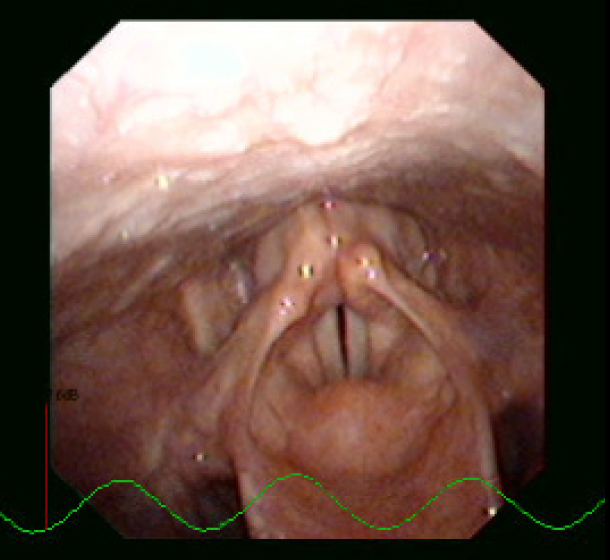Air added to the voice are produced at the vocal cord level, level 1. Air added to the voice is ONLY to be used in Neutral with air.
Methods
In June 2007, 2012 and 2014 Julian McGlashan and Cathrine Sadolin performed endoscopy studies and endoscopy/high speed studies in 2012 and 2014 at CVI in Copenhagen.
Twenty-one singers (ten males and eleven females) in 2007, thirteen singers (seven male and six females) in 2012, and sixteen singers (seven males and nine females) in 2014, a total of 32 singers (fifteen male and seventeen females), trained in the Complete Vocal Technique were recruited and asked to produce a sustained vowel in Neutral and then adding air to that that mode. Subsequently they were asked to alternate between the ‘clear’ mode and the mode with air.
25 subjects had pictures that we could analyse for this particular study, so the rest were excluded as they could either not tolerate the examination, did not perform the air correctly, or the image quality was not adequate for interpretation.
Each singer was examined using an OTVS7 camera (Olympus) and ENFV2 videoscope (Keymed) coupled to the Laryngostrobe (Laryngograph) digital capture system. Laryngograph electrodes were positioned over the thyroid cartilages and an omnidirectional microphone placed at distance from the singer which allowed recordings at all levels of loudness. Also the ELG and acoustic signals were captured and analysed with the Speech Studio (Laryngograph) software program.
The Neutral with air video images were analysed by Julian McGlashan and Cathrine Sadolin and the appearance and relationship between the key anatomical features was agreed by consensus and documented. The consistent features were identified and descriptive and explanatory text to aid pattern recognition.
The Laryngeal gestures are more to be seen as patterns of progression from in the modes, rather than aboslutes. The progession in the patterns can be used as guidelines on how to identify the mode within each singer.
For the Neutral with air these are the parameters we looked at: the shape of the glottis, the position of the false cords, the anterior posterior narrowing, the shape of the pirriforma fossa, the hight of the larynx, the pharyngeal wall, the epiglottis and the arytenoid/cuneiform complex.
Not only did we look at what was changing between using the mode and the mode with air, we also looked at what was actually vibrating.
Aim
To get a better understanding of the laryngeal changes associated with air and to examine the interaction of supraglottic vibration during intentional air added and vocal fold vibration.
Levels
We gave the various parts in the vocal tract levels in order to identify and specify on which levels the various changes take place. The levels also make it easier to communicate where the changes take place. On the videos from the footage only the first 3-4 levels are seen. For more info on the level, click here.
Still of air added
Results
When we look at the video examples of the mode with and without air notice the visible gap between the vocal folds, which is bigger at the back. You can see that the back wall of the larynx is relaxed leaving the larynx open so you can see the vocal folds easily. You can also see the aryepiglottic fold is stretcheded and relaxed and the opening of the larynx (the laryngeal inlet) has a shape of an ‘open’ funnel which is rather wide at the top.
Also Notice the Neutral with air laryngograph waveform has a sinusoidal shape. This is because there is no contact between the vocal folds due to the gap, which means that a lot of air is added to the sound and the volume is soft. In another example of Neutral with air there is the initial sinusoidal waveform but a brief upward spike indicating momentary closure of the vocal folds.
Conclusion
Air can be done safely to the mode Neutral.
In all the examples where we can see the vocal folds, or look at the laryngograph trace, there seems to be a resonably regular pattern, and there didn’t appear to be any evidence of the effect (or any additional noises) being produced in the vocal fold level. There was evidence on endoscopy or from the Laryngograph of periodic vocal fold vibration.
But it need a good technique to ensure accurate vocal mode setting done correctly and an intentional application of the effect.
This information comes from a study effects with the title ‘Can vocal effects such as distortion, growling, rattle and grunting and be produced without traumatising the vocal folds?’. This study was presented by Julian McGlashan at PEVOC7 conference in Groningen, Netherlands, 2007.
This information comes from a study Visual Vocal Mode Test Study on stills, with the title ‘Laryngeal gestures and Laryngograph data associated with the four vocal modes as described in the Complete Vocal Technique method of singing teaching’. This study was presented by Cathrine Sadolin and Julian McGlashan at BVA ‘Choice for voice’ conference in London, England, 2010.

